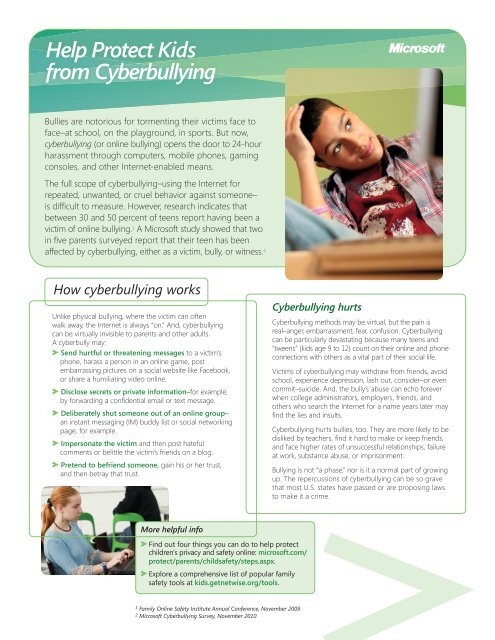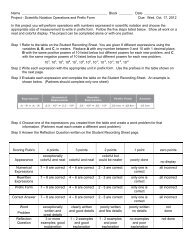Cyberbullying Fact Sheet
Cyberbullying Fact Sheet
Cyberbullying Fact Sheet
Create successful ePaper yourself
Turn your PDF publications into a flip-book with our unique Google optimized e-Paper software.
Help Protect Kids<br />
from <strong>Cyberbullying</strong><br />
m<br />
Bullies are notorious for tormenting their victims face to<br />
face–at school, on the playground, in sports. But now,<br />
cyberbullying (or online bullying) opens the door to 24-hour<br />
harassment through computers, mobile phones, gaming<br />
consoles, and other Internet-enabled means.<br />
The full scope of cyberbullying–using the Internet for<br />
repeated, unwanted, or cruel behavior against someone–<br />
is diffi cult to measure. However, research indicates that<br />
between 30 and 50 percent of teens report having been a<br />
victim of online bullying. 1 A Microsoft study showed that two<br />
in fi ve parents surveyed report that their teen has been<br />
affected by cyberbullying, either as a victim, bully, or witness. 2<br />
How cyberbullying works<br />
Unlike physical bullying, where the victim can often<br />
walk away, the Internet is always “on.” And, cyberbullying<br />
can be virtually invisible to parents and other adults.<br />
A cyberbully may:<br />
Send hurtful or threatening messages to a victim’s<br />
phone, harass a person in an online game, post<br />
embarrassing pictures on a social website like Facebook,<br />
or share a humiliating video online.<br />
Disclose secrets or private information–for example,<br />
by forwarding a confi dential email or text message.<br />
Deliberately shut someone out of an online group–<br />
an instant messaging (IM) buddy list or social networking<br />
page, for example.<br />
Impersonate the victim and then post hateful<br />
comments or belittle the victim’s friends on a blog.<br />
Pretend to befriend someone, gain his or her trust,<br />
and then betray that trust.<br />
<strong>Cyberbullying</strong> hurts<br />
<strong>Cyberbullying</strong> methods may be virtual, but the pain is<br />
real–anger, embarrassment, fear, confusion. <strong>Cyberbullying</strong><br />
can be particularly devastating because many teens and<br />
“tweens” (kids age 9 to 12) count on their online and phone<br />
connections with others as a vital part of their social life.<br />
Victims of cyberbullying may withdraw from friends, avoid<br />
school, experience depression, lash out, consider–or even<br />
commit–suicide. And, the bully’s abuse can echo forever<br />
when college administrators, employers, friends, and<br />
others who search the Internet for a name years later may<br />
fi nd the lies and insults.<br />
<strong>Cyberbullying</strong> hurts bullies, too. They are more likely to be<br />
disliked by teachers, fi nd it hard to make or keep friends,<br />
and face higher rates of unsuccessful relationships, failure<br />
at work, substance abuse, or imprisonment.<br />
Bullying is not “a phase,” nor is it a normal part of growing<br />
up. The repercussions of cyberbullying can be so grave<br />
that most U.S. states have passed or are proposing laws<br />
to make it a crime.<br />
More helpful info<br />
Find out four things you can do to help protect<br />
children’s privacy and safety online: microsoft.com/<br />
protect/parents/childsafety/steps.aspx.<br />
Explore a comprehensive list of popular family<br />
safety tools at kids.getnetwise.org/tools.<br />
1 Family Online Safety Institute Annual Conference, November 2009<br />
2 Microsoft <strong>Cyberbullying</strong> Survey, November 2010
m<br />
Help kids avoid cyberbullying<br />
Encourage children to make friends and to look out<br />
for each other. Cyberbullies are less likely to target those<br />
whom they perceive to have a strong network of friends,<br />
and usually stop when a victim’s friends rally around<br />
him or her.<br />
Talk with kids about cyberbullying. Ask your children what<br />
they are doing online–who they are meeting, what sites they<br />
visit, what games they play, and what they talk about. What<br />
may have started as a simple argument with one friend can<br />
slide into repeated online assaults with others joining in.<br />
Ask children to report bullying to you. Promise to take<br />
action on their behalf, and reassure them that you won’t<br />
curtail their phone, gaming, or computer privileges.<br />
Look for signs of online bullying–for example, getting<br />
upset when online or texting or talking on the phone, or<br />
a reluctance to go to school or after-school activities.<br />
Don’t tolerate cyberbullying. Let your children know<br />
they should never, under any circumstances, bully<br />
someone. Make the consequences clear.<br />
Keep passwords a secret. Urge kids not to share<br />
passwords or other information that could be used to bully<br />
them, and not to loan their phones or laptop computers.<br />
Turn on safety features available in most programs<br />
and services such as those in Windows ® 7, Xbox LIVE ® ,<br />
and the Zune ® digital media player. (Get details for<br />
Microsoft products at microsoft.com/protect/<br />
tools/childsafety/compare.aspx.)<br />
What to do if someone is<br />
cyberbullying your child<br />
Children need to know that you will give positive, active,<br />
and predictable support.<br />
Act immediately. Don’t wait to see if the abuse will stop.<br />
If you feel that your child is physically at risk, call the<br />
police at once.<br />
Acknowledge the pain. It’s important for kids to hear<br />
you affi rm that what happened wasn’t fair or right. Make<br />
sure they understand:<br />
That “only weaklings tattle” is a myth. Those who get<br />
help are the ones who are not willing to be bullied.<br />
They are not at fault. The bully is not attacking because<br />
of some flaw–“I’m fat, a nerd, wear glasses…” The bully is<br />
simply justifying his or her actions.<br />
Tell your kids not to respond or retaliate because<br />
bullies are looking for a reaction. Don’t answer a bully’s<br />
calls, or reply to (or even read) text messages or online<br />
attacks. Do save the material in case the authorities need it.<br />
Block anyone whose behavior is inappropriate or<br />
threatening in any way. Check with the service–social<br />
networking, IM, mobile phone–to fi nd out how.<br />
Report the problem. Every effort should be made to<br />
hold the cyberbully accountable.<br />
If the bully is a student, consider reporting it to the school.<br />
Report bullying to the website or company where the<br />
abuse occurred. For example, in Microsoft ® services or<br />
software, look for a Report Abuse link or contact us at<br />
www.microsoft.com/reportabuse.<br />
Content contributor<br />
© 2010 Microsoft. This material is provided for informational purposes only.<br />
Microsoft makes no warranties, express or implied.<br />
1110 Part No. 098-109733







![Poetry Book Report [created by Mrs. Kucinskas]](https://img.yumpu.com/42940863/1/190x245/poetry-book-report-created-by-mrs-kucinskas.jpg?quality=85)








